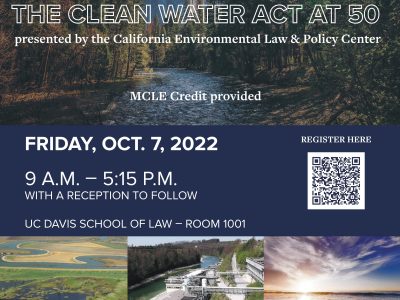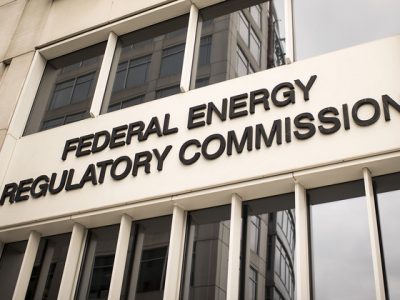Clean Water Act
Happy 50th Anniversary, Federal Clean Water Act
One of America’s Foundational Environmental Laws Has Proven Transformational, But Requires Updating a Half-Century Later
The Clean Water Act (CWA), one of the nation’s most important environmental laws, is 50 years old today. It’s proven to be one of the most successful of America’s bedrock federal environmental statutes. But the CWA is far from perfect, needs some important updating, and will probably never fully achieve the aspirational goals Congress proclaimed …
Continue reading “Happy 50th Anniversary, Federal Clean Water Act”
CONTINUE READINGU.C. Davis Law School to Host “Clean Water Act at 50” Conference
Interdisciplinary Event Will Assess Landmark Law’s Past, Assess Its Future
On Friday, October 7th, the California Environmental Law & Policy Center at U.C. Davis School of Law will convene a major, day-long conference to commemorate the 50th anniversary of the federal Clean Water Act. The event will assess the progress the U.S. has made over the past half-century in abating water pollution; focus on some …
Continue reading “U.C. Davis Law School to Host “Clean Water Act at 50” Conference”
CONTINUE READINGWill the Supreme Court Gut the Clean Water Act?
We’re about to find out in an upcoming case.
What wetlands and waterbodies does the Clean Water Act protect? Congress failed to provide a clear answer when it passed the statute, and the issue has been a bone of contention ever since. The Biden Administration is in the process of issuing a new regulation on the subject. Normally, you’d expect the Supreme Court to …
Continue reading “Will the Supreme Court Gut the Clean Water Act?”
CONTINUE READINGTwo FERC Cases and Why They Matter
Last week’s D.C. Circuit cases illustrate why environmental lawyers need to understand FERC.
The Federal Energy Regulatory Commission (FERC) has been called the most important environmental agency that no one has heard of. At the end of last week, the D.C. Circuit decided two undramatic FERC cases that illustrate FERC’s environmental significance. One involved a bailout to coal and nuclear plants, the other involved water quality. The first …
Continue reading “Two FERC Cases and Why They Matter”
CONTINUE READINGThe Quagmire of Clean Water Act Jurisdiction
The scope of federal jurisdiction over water bodies and wetlands remains as murky as ever.
The Biden Administration announced on Monday that it would not meet a February target date to issue a revised definition of federal jurisdiction under the Clean Water Act. It still plans to issue a revised definition later in the year. That sounds like a very technical issue. But it actually determines the extent to which …
Continue reading “The Quagmire of Clean Water Act Jurisdiction”
CONTINUE READINGThe U.S. Supreme Court’s Most Important 2020 Environmental Law Decisions
Clean Water Act, CERCLA, Native American Law and Trump’s Border Wall Lead the List
It’s become customary for critics and observers from many disciplines to publish a wide variety of lists at year’s end, nominating the most important or best movies, music, plays, etc. of the preceding year. Why not follow that tradition in the fields of environmental law and policy? With that objective in mind, I plan over …
Continue reading “The U.S. Supreme Court’s Most Important 2020 Environmental Law Decisions”
CONTINUE READINGTrump’s Latest Deregulatory Ploy: Emergency Waivers
Shaky legal authority, poor analysis, dubious benefits. What else is new?
In an Executive Order issued last Thursday, Trump told agencies to use emergency waivers to avoid environmental safeguards. The order is legally shaky and unlikely to accomplish much. Still, it provided a nice photo op. Maybe he should have signed it in front of a church. I’ll talk later about the specifics, but first I’d …
Continue reading “Trump’s Latest Deregulatory Ploy: Emergency Waivers”
CONTINUE READINGGuest Contributors Helen Kang and Deborah Sivas: California Should Lead the Nation in Controlling Agricultural Pollution
Protection of Drinking Water and Environmental Quality Demands Strong Action
Agricultural runoff is one of the largest sources of pollution in the nation’s waterways. In recent years, scientific journals and the media have been filled with reports of toxic algae blooms and dead zones near and far: The Everglades, Great Lakes, Gulf of Mexico, Chesapeake Bay, and San Francisco Bay-Delta. Agricultural pollution also threatens public …
CONTINUE READINGHere Today, Gone to Maui
U.S. Supreme Court Issues Environment-Friendly Ruling in Major Clean Water Act Case
This week the U.S. Supreme Court issued its decision in the Court’s most important environmental law case of the current Term: County of Maui v. Hawaii Wildlife Fund. In a somewhat surprising ruling, the justices rejected both sides’ argument over the scope of government authority to regulate water pollution discharges under the federal Clean Water …
Continue reading “Here Today, Gone to Maui”
CONTINUE READINGWhy is Newsom vetoing SB 1?
Comparing the Governor’s statements with the text of the bill
The California legislature recently passed SB 1, which would translate into state law a range of federal environmental and worker safety standards that were in place before the inauguration of President Trump to protect against federal roll backs in those areas. However, Governor Newsom has indicated he will veto SB 1, on the grounds that …
Continue reading “Why is Newsom vetoing SB 1?”
CONTINUE READING











